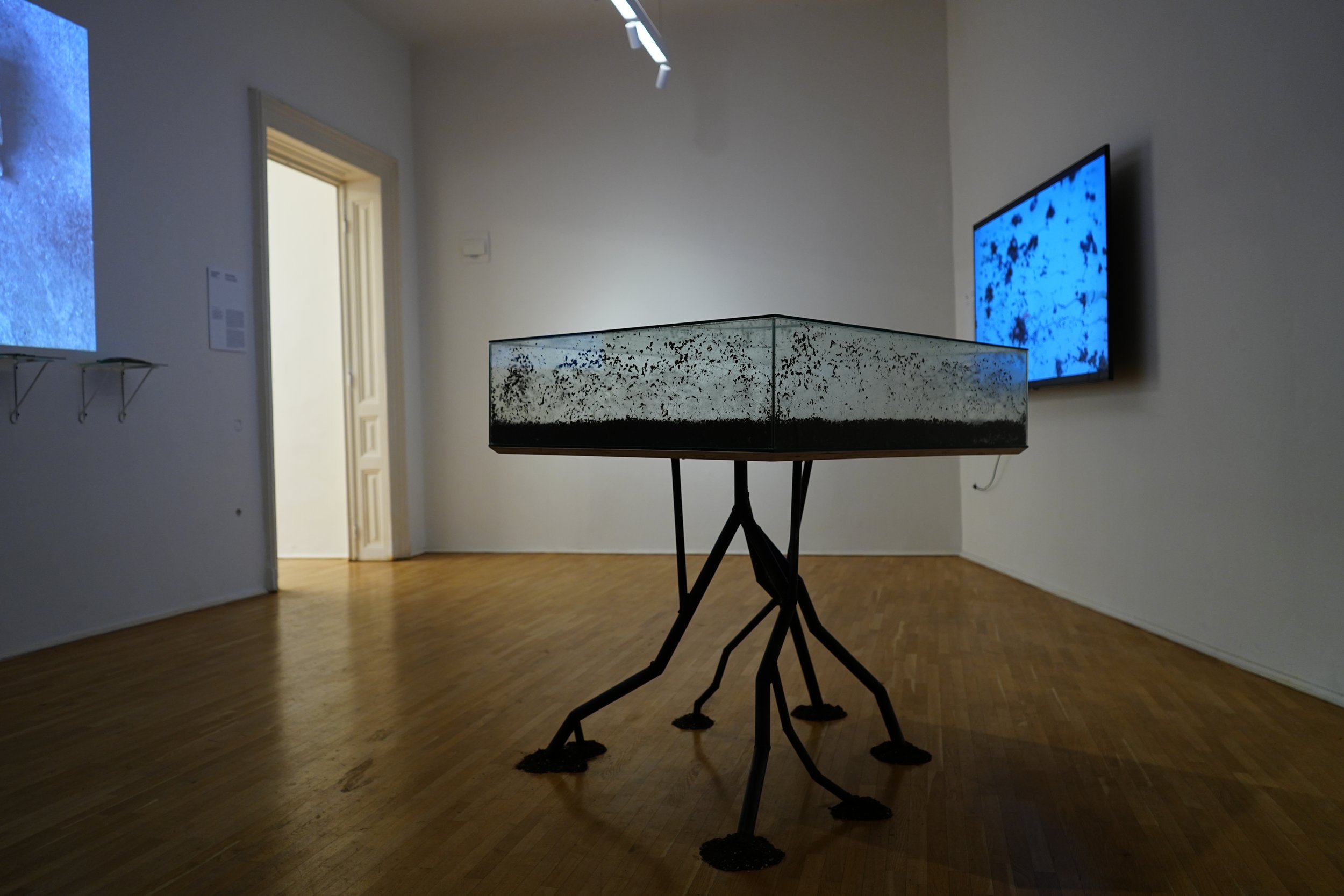About















𝗙𝘂𝘀𝗶𝗼𝗻:𝗔𝗜𝗥
Curatoare: Raluca Oancea
Director Artistic: Mihaela Ghiță
Ediția de anul acesta a reunit 6 artiști, dintre care 4 români și 2 străini: Alexandra Costea, Denis Flueraru, Maria Nalbantova (BG), Mihai Popescu, Ole Blank (DE) și Zoița Delia Calinescu.
Fusion:AIR se plasează la intersecția dintre biofilie și tehnofilie, oferind o viziune inovatoare asupra modului în care arta contemporană poate contribui la depășirea crizei ecologice globale. Inspirată de manifestul „Living in the Anthropocene” (Crutzen & Schwägerl, 2011), expoziția refuză atât utopiile unui paradis natural pierdut, cât și distopiile unei lumi complet artificializate, propunând în schimb un teritoriu de întrepătrundere și hibridizare între uman și nonuman, între organic și tehnologic. Artiștii participanți își găsesc inspirația în teoreticienii postumaniști și eco-fenomenologici, conturând noi relații între născut și construit, între natură și cultură. Fusion AIR: Biophilia Technophilia aduce în prim-plan creații ce valorifică legile naturii și inovațiile tehnologice, reflectând atât frumusețea, cât și complexitatea lumii contemporane.” (Raluca Oancea, curatoarea expoziției.)
𝐀𝐥𝐞𝐱𝐚𝐧𝐝𝐫𝐚 𝐂𝐨𝐬𝐭𝐞𝐚 investighează în 𝑆𝑡𝑟𝑢𝑐𝑡𝑢𝑟𝑖 𝑖𝑚𝑒𝑚𝑜𝑟𝑖𝑎𝑙𝑒 memoria și structura microscopică a pietrei, explorând conservarea și transformarea tufului vulcanic zeolitic prin tratare cu plasmă. Lucrarea ridică întrebări despre percepție și memorie în fața trecerii timpului.
𝗗𝗲𝗻𝗶𝘀 𝗙𝗹𝘂𝗲𝗿𝗮𝗿𝘂 dezvăluie prin instalația interactivă 𝑆𝑜𝑙𝑎𝑟𝑎 relația fragilă dintre omenire și soare, subliniind cum sursa vieții poate deveni și un factor de risc. Nimeni nu știe care e sunetul exploziilor solare, dar Denis invită vizitatorii să îl descopere printr-o instalație interactivă.
Artista bulgară 𝗠𝗮𝗿𝗶𝗮 𝗡𝗮𝗹𝗯𝗮𝗻𝘁𝗼𝘃𝗮 plaseză retrocauzalitatea, un concept din fizica cuantică ce sugerează că efectele pot influența cauzele în centrul lucrării sale 𝑇ℎ𝑒 𝑃𝑜𝑜𝑙 𝑖𝑠 𝑁𝑒𝑣𝑒𝑟 𝐸𝑚𝑝𝑡𝑦. ”Nu știm încă, dacă viitorul poate influența trecutul.” Lucrarea vorbește despre istoria Conacului Oteteleșanu care a funcționat ca Școală de fete. Acum la Măgurele lucrează și activează numeroase femei cercetătoare. Lucrarea Mariei explorează conexiunile fluide dintre uman și nonuman, utilizând apă din lacul Oteteleșanu și imagini microscopice pentru a specula retrocauzalitatea.
𝗠𝗶𝗵𝗮𝗶 𝗣𝗼𝗽𝗲𝘀𝗰𝘂 (𝐻𝑜𝑤 𝑙𝑜𝑛𝑔 𝑠ℎ𝑜𝑢𝑙𝑑 𝑎𝑟𝑡/𝑚𝑒𝑚𝑜𝑟𝑦 𝑙𝑎𝑠𝑡?) compară durabilitatea pergamentelor tradiționale cu fragilitatea mediilor digitale moderne, invitând vizitatorii să reflecteze asupra modului în care arta și memoria pot fi conservate în timp.
𝗢𝗹𝗲 𝗕𝗹𝗮𝗻𝗸 propune 𝑂𝑠𝑝𝑎̆𝑡̦𝑢𝑙 𝑑𝑒 𝑙𝑎 𝑚𝑖𝑒𝑧𝑢𝑙 𝑛𝑜𝑝𝑡̦𝑖𝑖, o sculptură interactivă care implică râme ca actori principali, simbolizând transformarea materialelor naturale într-un nou strat fertil de sol, demonstrând continuumul regenerativ al naturii.
𝗭𝗼𝗶𝘁̦𝗮 𝗗𝗲𝗹𝗶𝗮 𝗖𝗮̆𝗹𝗶𝗻𝗲𝘀𝗰𝘂 va expune experimentul 𝑇ℎ𝑒 𝑆𝑢𝑐𝑐𝑒𝑠𝑠 𝐴𝑛𝑑 𝑇ℎ𝑒 𝐹𝑎𝑖𝑙𝑢𝑟𝑒𝑠 𝑂𝑓 𝐴 𝐵𝑒𝑎𝑢𝑡𝑖𝑓𝑢𝑙 𝑃𝑟𝑎𝑐𝑡𝑖𝑐𝑒 care studiază impactul diferitelor metode de irigare asupra plantelor, incluzând tehnici experimentale precum apa activată cu plasmă, pentru a descoperi soluții de adaptare la viitorul climatic.
Institute de cercetare partenere:
- Institutul Național de Cercetare și Dezvoltare pentru Fizica Materialelor (INFIM)
- Institutul Național pentru Fizica Laserilor, Plasmei și Radiației (INFLPR)
- Institutul de Științe Spațiale (ISS)
- Centrul de Cercetare pentru Studiul Calității Produselor Agroalimentare (USAMV)
- Institutul Național de Cercetare și Dezvoltare pentru Textile și Pielărie (INCDTP)
Parteneri instituționali:
Institutul Goethe
/SAC - Spațiul de Artă Contemporană
EN
Curator: Raluca Oancea
Art Director: Mihaela Ghiță
Held over 3 weeks, the free exhibition showcased 6 original and unique artworks created by artists from Romania, Germany and Bulgaria.
"Fusion:AIR stands at the intersection of biophilia and technophilia, offering an innovative vision of how contemporary art can contribute to overcoming the global ecological crisis. Inspired by the manifesto "Living in the Anthropocene" (Crutzen & Schwägerl, 2011), the exhibition refuses both the utopias of a lost natural paradise and the dystopias of a completely artificial world, proposing instead a territory of interpenetration and hybridization between human and nonhuman, between organic and technology. Participating artists find their inspiration in posthumanist and eco-phenomenological theorists, outlining new relationships between born and built, between nature and culture. Fusion AIR: Biophilia Technophilia brings to the forefront creations that harness the laws of nature and technological innovations, reflecting both the beauty and complexity of the contemporary world." (Raluca Oancea, curator of the exhibition.)
𝗔𝗹𝗲𝘅𝗮𝗻𝗱𝗿𝗮 𝗖𝗼𝘀𝘁𝗲𝗮 investigates in 𝐼𝑚𝑚𝑒𝑚𝑜𝑟𝑖𝑎𝑙 𝑆𝑡𝑟𝑢𝑐𝑡𝑢𝑟𝑒𝑠, the memory and microscopic structure of stone, exploring the preservation and transformation of zeolitic volcanic tuff through plasma treatment. The work raises questions about perception and memory in the face of the passage of time.
𝗗𝗲𝗻𝗶𝘀 𝗙𝗹𝘂𝗲𝗿𝗮𝗿𝘂 reveals through the interactive installation 𝑆𝑜𝑙𝑎𝑟𝑎 the fragile relationship between humanity and the sun, emphasizing how the source of life can also become a risk factor. No one knows what the sound of solar explosions is, but Denis invites visitors to discover it through an interactive installation.
𝑇ℎ𝑒 𝑃𝑜𝑜𝑙 𝑖𝑠 𝑁𝑒𝑣𝑒𝑟 𝐸𝑚𝑝𝑡𝑦: Bulgarian artist 𝗠𝗮𝗿𝗶𝗮 𝗡𝗮𝗹𝗯𝗮𝗻𝘁𝗼𝘃𝗮 places 𝑟𝑒𝑡𝑟𝑜𝑐𝑎𝑢𝑠𝑎𝑙𝑖𝑡𝑦, a concept from quantum physics that suggests that effects can influence causes, at the heart of her work. . "We don't know yet if the future can influence the past." The work talks about the history of the Oteteleșanu Manor which functioned as a girls' school. Now at Măgurele, many women work and are active. Maria's work explores the fluid connections between human and nonhuman, using water from Oteteleșanu Lake and microscopic images to speculate retrocausality.
𝗠𝗶𝗵𝗮𝗶 𝗣𝗼𝗽𝗲𝘀𝗰𝘂 (𝐻𝑜𝑤 𝑙𝑜𝑛𝑔 𝑠ℎ𝑜𝑢𝑙𝑑 𝑎𝑟𝑡/𝑚𝑒𝑚𝑜𝑟𝑦 𝑙𝑎𝑠𝑡?) compares the durability of traditional scrolls with the fragility of modern digital media, inviting visitors to reflect on how art and memory can be preserved over time.
𝗢𝗹𝗲 𝗕𝗹𝗮𝗻𝗸 proposes the 𝑀𝑖𝑑𝑛𝑖𝑔ℎ𝑡 𝐹𝑒𝑎𝑠𝑡, an interactive sculpture involving earthworms as the main actors, symbolizing the transformation of natural materials into a new fertile layer of soil, demonstrating the regenerative continuum of nature.
𝗭𝗼𝗶𝘁̦𝗮 𝗗𝗲𝗹𝗶𝗮 𝗖𝗮̆𝗹𝗶𝗻𝗲𝘀𝗰𝘂 will present the experiment 𝑇ℎ𝑒 𝑆𝑢𝑐𝑐𝑒𝑠𝑠 𝐴𝑛𝑑 𝑇ℎ𝑒 𝐹𝑎𝑖𝑙𝑢𝑟𝑒𝑠 𝑂𝑓 𝐴 𝐵𝑒𝑎𝑢𝑡𝑖𝑓𝑢𝑙 𝑃𝑟𝑎𝑐𝑡𝑖𝑐𝑒 which studies the impact of different irrigation methods on plants, including experimental techniques such as plasma-activated water, in order to discover solutions for adapting to the future climate.
Scientific institutes:
National Institute for Laser, Plasma& Radiation Physics
National Institute of Materials Physics
ISS - Institute of Space Science
Institute of Research and Development for Textiles and Leather
Universitatea de Științe Agronomice și Medicină Veterinară București
Institutional partners:
Goethe Institute
/SAC - Contemporary Art Space
